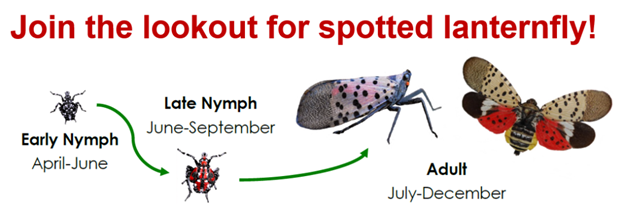Spotted Lanternfly
go.ncsu.edu/readext?851259
en Español / em Português
El inglés es el idioma de control de esta página. En la medida en que haya algún conflicto entre la traducción al inglés y la traducción, el inglés prevalece.
Al hacer clic en el enlace de traducción se activa un servicio de traducción gratuito para convertir la página al español. Al igual que con cualquier traducción por Internet, la conversión no es sensible al contexto y puede que no traduzca el texto en su significado original. NC State Extension no garantiza la exactitud del texto traducido. Por favor, tenga en cuenta que algunas aplicaciones y/o servicios pueden no funcionar como se espera cuando se traducen.
Português
Inglês é o idioma de controle desta página. Na medida que haja algum conflito entre o texto original em Inglês e a tradução, o Inglês prevalece.
Ao clicar no link de tradução, um serviço gratuito de tradução será ativado para converter a página para o Português. Como em qualquer tradução pela internet, a conversão não é sensivel ao contexto e pode não ocorrer a tradução para o significado orginal. O serviço de Extensão da Carolina do Norte (NC State Extension) não garante a exatidão do texto traduzido. Por favor, observe que algumas funções ou serviços podem não funcionar como esperado após a tradução.
English
English is the controlling language of this page. To the extent there is any conflict between the English text and the translation, English controls.
Clicking on the translation link activates a free translation service to convert the page to Spanish. As with any Internet translation, the conversion is not context-sensitive and may not translate the text to its original meaning. NC State Extension does not guarantee the accuracy of the translated text. Please note that some applications and/or services may not function as expected when translated.
Collapse ▲Written by: Aimee Jarrels, Extension Master Gardener Volunteer of Pender County
When it comes to bugs, the Spotted Lanternfly is an attractive species of moth-like insects. Pretty or not, you may not want to watch your beautiful garden succumbing to the wrath of these bugs.
What is the Spotted Lanternfly and How to Spot One?
Spotted lanternflies are pale gray insects covered in blackspots and geometrical lines that look carefully painted. Their forewings are generally gray, while the hind wings are black and crimson, which are only seen in flight. The bug is roughly an inch long and half an inch wide. It has a blackhead, black sets of legs, and a yellow abdomen etched with black bands.
The Spotted Lanternfly originates from China (primary point of origin), India, and East Asia. The first case in the United States was reported in 2014 in Pennsylvania. The pest most likely hitchhiked a shipment of stones from Asia. The ‘bad’ bug is a relatively newer species that has invaded about ten northeastern American states as of now, including Connecticut, Delaware, Indiana, Maryland, Massachusetts, New Jersey, New York, Ohio, Pennsylvania, Virginia, and Virginia.
Their original host is the tree-of-heaven (or Ailanthus altissima), a Chinese tree that was imported to the States back in 1784 and became a common weed across North America. Recent infestations have been reported to occur in vineyards, edible and ornamental plants, different species of trees, and orchard fruits, to name a few.
The Spotted Lanternfly is an aggressive species that can cause huge agricultural and economic damage roughly estimated at $100 million in Pennsylvania alone. Already, the pest has destroyed vineyards and delayed shipments of several products, from lumber to milk.
The bug is a nuisance for homeowners and gardeners as well, devouring more than 70 species of edible and ornamental plants and ruining home landscapes. Besides eating away our precious gardens, the bugs tend to leave behind a sticky substance called honeydew that promotes the growth of black mold on plants.
How to get rid of Spotted Lanternfly from your Gardens?
Everyone is asked to stay vigilant and report spotted lanternfly if you see or suspect that you see it since it has not been seen in NC yet. Please take a picture and submit it in an email to badbug@ncagr.gov or call the North Carolina Department of Agriculture and Consumer Services at 919-707-3730. The tragic scene of your ruined plants and harvest can be avoided by stomping on the invasive and destructive bugs, quite literally. The expert’s recommendation for lanternfly control is stomping and squashing these bugs. The official slogan of New Jersey for the battle against the infestation of the Spotted Lanternfly is, “Join the battle, beat the bug! Stomp it out!”
The method of prevention and management depends on the scale of the problem as well as the area in consideration. For simple home gardens, stomping these bugs or picking them out is an effective control measure to save your gardens.
If the problem exists on a larger scale, it is advisable to turn to chemical solutions under the guidance of an expert. Insecticides containing pyrethroids seem to work effectively for nymphs up to the third instar. However, stronger doses of insecticides are needed to work against adult lanternflies. This is why the pest problem should be tackled early on.
For larger areas, like vineyards, farms, and orchards, heavy application of insecticides is unfavorable to the crops. In these cases, it is better to take the help of a professional. However, so far, lanternflies are most damaging to grapevines. For other crops, these bugs are stressors, and watering the plants should restore the sap that has been sucked out.




